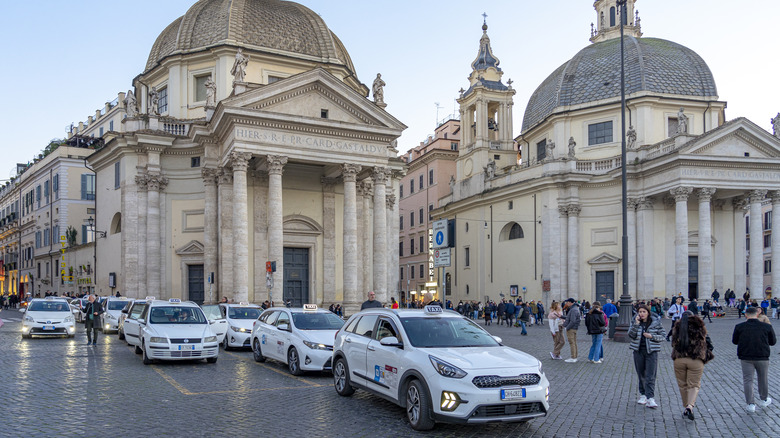Why Tourists In Italy Shouldn't Even Try To Flag Down A Taxi
For those of us who've spent time in U.S. cities, flagging down taxis has become second nature. But travelers should know that this practice is not universal. In Italy, for example, drivers might occasionally stop when you wave at them, just to be polite, but they're not actually supposed to. And in a more sinister twist, taxis that flout the rules and respond to unknowing, hand-flapping tourists may be "unregistered" taxis, which have been known to rip people off. Therefore, to abide by the rules and keep yourself safe from taxi scams, avoid taxi hailing when in Italy.
What you should do instead is head to the main train station, a major tourist attraction, or one of the main squares (piazzas) in the city you're visiting, most of which have designated taxi stands. If more than one person is waiting for a cab at this location, get in line behind them, and when it's your turn, the next available taxi will pick you up. In Florence, for example, taxi stands can be found at intersections near the main train station, Santa Maria Novella, and the famous bridge Ponte Vecchio, along with many of the city's piazzas, such as Piazza San Marco, Piazza della Republica, and others. Some of the bigger Italian cities (e.g., Rome) publish lists of all the taxi stand locations to eliminate the guesswork; you can quickly find these sites via a simple Google search.
Other ways to find a taxi in Italy
If you're in Italy and you want the taxi to come to you versus the other way around, you have to call them on the phone. Again, in most major Italian cities, it's pretty easy to find contact information for taxi companies via Google. You're probably wondering right about now, "Can't I just use Uber in Italy?" The simple answer to that question is yes, if you're in a major city like Rome or Milan. But for now, only Uber Black is available, which is usually more expensive than a regular taxi. In other words, the cheap and easy Uber service that you're familiar with in the U.S. and other countries is currently not available in Italy.
However, those who appreciate the convenience of using apps to find rides can use an app like WeTaxi, which is very popular throughout Italy. Like the Uber app, it employs geolocation to estimate the fare to get you from where you are to your desired destination, and then enables you to call a nearby driver. Other apps with similar capabilities are FreeNow, ItTaxi, and Apptaxi. The FreeNow app allows you to reserve a taxi four days in advance, and ItTaxi saves your regular routes. Through Apptaxi, users can earn miles and discounts. However, do note that not all of these apps work in all Italian towns and cities. Speaking of apps, check out our article on our favorite travel itinerary app.
Less expensive ways to get around Italian cities
Now you know that taxi flagging is one of those things tourists should never do when visiting Italy and what you should do instead to find a ride. But what if you use one of the above-mentioned apps to estimate your taxi fare and end up with sticker shock? While taxi rides in Italy are not as expensive as they are in Switzerland, they are generally higher than in other southern European countries, like Greece, Spain, and Portugal. So we totally get that you might have second thoughts about hitching that ride to the Colosseum.
Here's our first bit of advice for controlling those transportation costs within Italy's big cities: When you can, walk. Invest in a high-quality pair of walking shoes, load up your backpack with water and sunscreen, and hit the road. Most cities and towns in Italy are infinitely walkable, and the great news is that the more you walk, the more pasta, pizza, and gelato you can eat without gaining weight on your vacation. Another option to consider is the underground metro if you're in Milan, Rome, Naples, Turin, Brescia, Catania, or Genoa. While these metro systems may not be as large as those in other European urban areas, they can often get you where you need to go quickly and cheaply. Buses are also a much more affordable alternative to taxis, with comprehensive bus networks within and between most Italian towns and cities.


